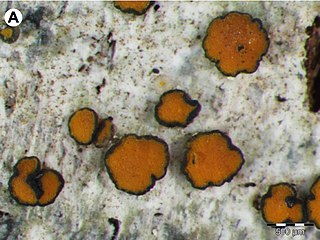Agonimia is a genus of lichen-forming fungi in the family Verrucariaceae.

Lecidella is a genus of crustose lichens in the family Lecanoraceae.

Lobothallia is a genus of lichens in the family Megasporaceae. Species in the genus have foliose thalli that become crustose areolate in the center with age, and grow on calcareous to siliceous rocks. The crustose part of the body may keep its lower cortex, though not always. Dark brown to black apothecia may be sunken into the surface of the thallus, as indicated in the common name puffed sunken disk lichen. Members grow to 3–5 cm (1.2–2.0 in) or more radiating lobes (placoidioid). The photobiont is green alga from the genus Trebouxia. The genus is represented in Eurasia, Asia, North Africa, Central America, western North America, and Australia.

Palicella is a genus of crustose lichens in the family Lecanoraceae. It contains five species.
Coppinsidea is a genus of two species of crustose lichens in the family Ramalinaceae. It was circumscribed in 2019 by lichenologists Sergey Kondratyuk, Edit Farkas, and Laszlo Lőkös with Coppinsidea sphaerella designated as the type species. Species of Coppinsidea are similar in appearance and morphology to Thamnolecania, but differ from them in having a thallus that is crustose (rather than fruticose, mostly convex to almost spherical apothecia that are lecideine or biatorine in structure, as well as in being distributed in the Northern Hemisphere.
Coppinsidea vainioana is a species of crustose lichen in the family Ramalinaceae. It occurs in Europe, where it grows on the bark of pine trees.

Igneoplaca is a genus in the subfamily Xanthorioideae of the family Teloschistaceae. It contains a single species, the crustose lichen Igneoplaca ignea.
Sedelnikovaea is a genus of placodioid lichens in the family Lecanoraceae. The genus was circumscribed in 2015 by Sergey Kondratyuk, Min-Hye Jeong, and Jae-Seoun Hur to contain Sedelnikovaea baicalensis, the type species. Three additional species were transferred into the genus in 2019.

Ikaeria is a genus of two species of crustose lichens in the family Teloschistaceae. Both species grow on twig bark of shrubs and trees. It was circumscribed in 2017 by lichenologists Sergey Kondratyuk, Dalip Kumar Upreti, and Jae-Seoun Hur, with Ikaeria aurantiellina assigned as the type species. This lichen was previously placed in the genus Caloplaca, but molecular phylogenetic analysis showed that it belonged in a lineage that was genetically distinct from that genus. Ikaeria serusiauxii was added to the genus in 2020.

Ikaeria serusiauxii is a species of crustose lichen in the family Teloschistaceae. It is found in the Madeira Archipelago and Canary Islands (Macaronesia), as well as in coastal regions of Algarve and Estremadura in mainland Portugal, where it grows on twigs and branches of trees and shrubs. It was described as a new species in 2020 by lichenologist Harrie Sipman. The type specimen was found on Porto Santo Island, on the lower slopes of Pico do Facho, at an altitude of about 350 m (1,150 ft). Here it was growing on fallen pine trees. The specific epithet honours Belgian lichenologist Emmanuël Sérusiaux, "who contributed significantly to the exploration of the lichen diversity of Macaronesia".
Sirenophila is a genus of crustose lichens in the subfamily Teloschistoideae of the family Teloschistaceae. It has four species with an Australasian distribution.
Caloplaca kedrovopadensis is a little-known species of crustose lichen in the family Teloschistaceae. It is only found in the Kedrovaya Pad Nature Reserve in the Russian Far East, and on the Jiri Mountain of South Korea. The lichen has been recorded growing on rocks and on bark.
Lecanora ussuriensis is a species of saxicolous (rock-dwelling) lichen in the family Lecanoraceae. It is found in single localities in the Primorsky Krai region of the Russian Far East, as well as in Japan.
Opegrapha verseghyklarae is a little-known species of lichenicolous (lichen-eating) fungus in the family Teloschistaceae. It is found in the Russian Far East, where it grows on the thalli and apothecia of the crustose lichen Ochrolechia pallescens.
Lecanora lojkahugoi is a species of saxicolous (rock-dwelling) crustose lichen in the family Lecanoraceae. It is found in the Russian Far East and in South Korea.
Biatora oxneri is a species of corticolous (bark-dwelling) lichen in the family Ramalinaceae. It is found in the Russian Far East and in South Korea.
Oxneria ussuriensis is a species of corticolous, crustose lichen in the family Teloschistaceae. It is found in a single location in the Russian Far East.
Dibaeis yurii is a little-known species of terricolous (ground-dwelling) lichen in the family Icmadophilaceae. It is found in the Russian Far East and in South Korea.
Klára Anna Verseghy was a Hungarian lichenologist. She was the curator of the lichen collection of the Hungarian Natural History Museum in Budapest from 1958 to 1985.
Neobrownliella is a genus of crustose lichens in the subfamily Teloschistoideae of the family Teloschistaceae. It has five species. The genus was circumscribed in 2015 by lichenologists Sergey Kondratyuk, Jack Elix, Ingvar Kärnefelt, and Arne Thell, with Neobrownliella brownlieae assigned as the type species. It is a segregate of the large genus Caloplaca. Characteristics of Neobrownliella include a thallus that is continuous or areolate, the presence of anthraquinones as lichen products, a cortical layer with a palisade paraplectenchyma, and the lack of a thick palisade cortical layer on the underside of the thalline exciple. Two species were included in the original circumscription of the genus; an additional three species were added in 2020.




